Tran Binh Loc, circa 1935-36, « The Little Brother », or the tragic figure
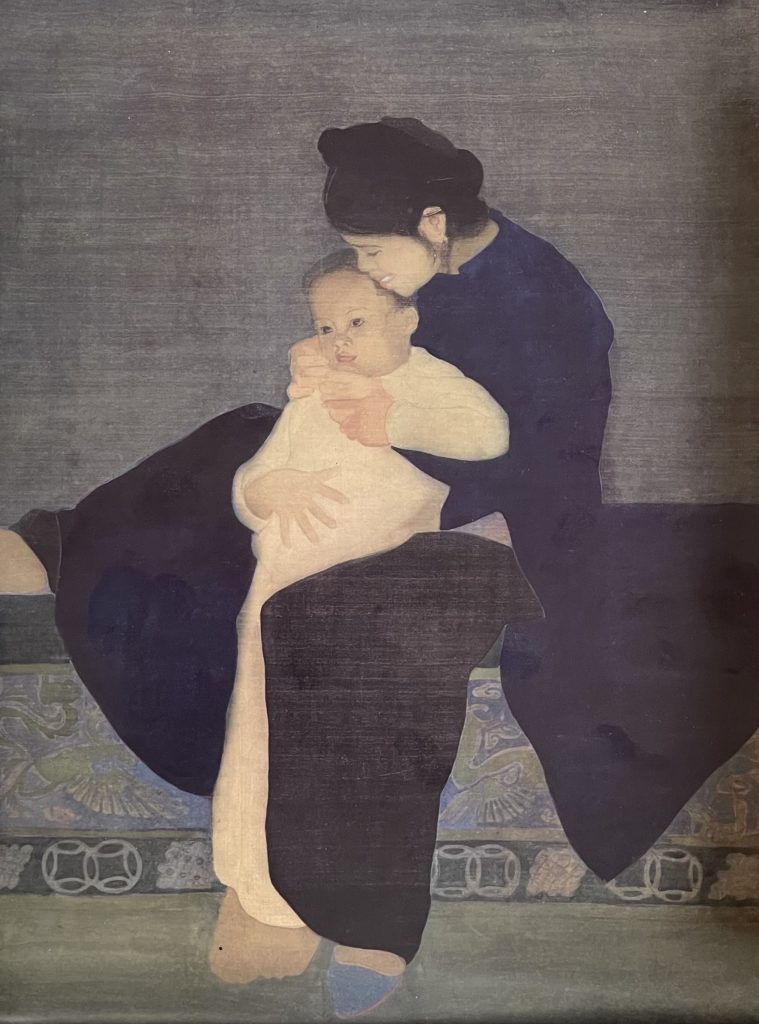
In this striking gouache and ink on silk (65X49cm), titled and signed on the back, executed circa 1935-36, Trần Bình Lộc (1914-1941) offers us two figures, to be identified as a “little brother” (according to the title on the back) and his sister (which will remain a guess).
They appear in a bare room whose austerity is challenged only by the polychrome fabric covering the bench. A horizontal band of phoenixes overhangs an equally horizontal row of double-sapecs and a more difficult-to-identify motif.
In Vietnam, as in China, the phoenix has an auspicious meaning. The interested reader may wish to consult Karl Petit (Le monde des symboles dans l’art de la Chine Études Orientales N° 9, Thanh Long Bruxelles1982), who analyzes its full significance. Let’s simply note that the double-sapèque, appearing alongside two other symbols – here the phoenix and our illegible motif, which we credit as a symbol – expresses the meaning of “both complete”, phonically resembling “two sapèques”.
This “both complete” perfectly expresses the presumed sentiment of the two characters and the feelings they display.
Trần Bình Lộc expresses an asymmetrical fusion between the child and the young woman.
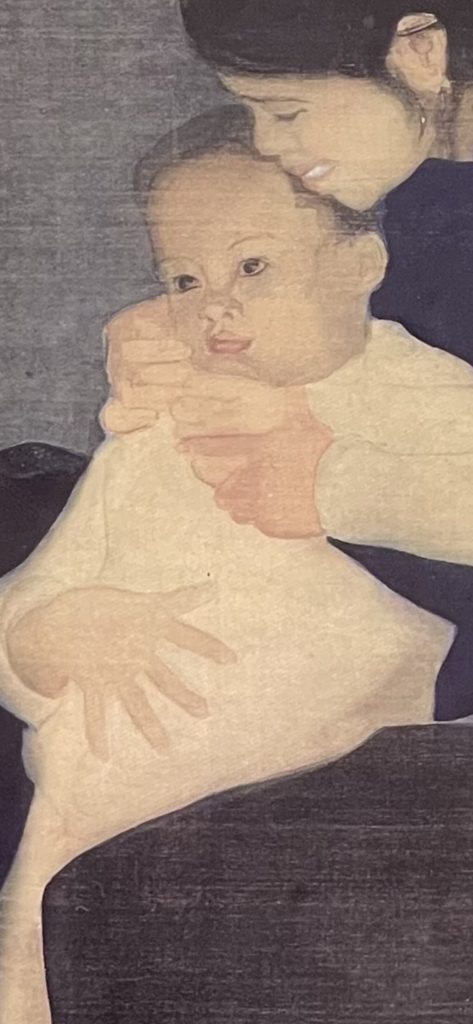
The latter, confident, abandons himself to his sister’s sensing arms. Her – too – large feet, firmly planted on the ground, display an independence enhanced by her gaze into the distance, but challenged by her leaning against her sister.
This one, with her cheerful face, is devoted entirely to him, looks only at him, and embraces him with her two capturing hands, her left leg resting on the floor, her right, stretched out on the bed.
The child, with his anatomically oversized hands, places his right hand on her abdomen, while with his left, he seems to want to unclench the embrace…
The artist fixes the symbiosis, also asymmetrical, of the two by using a luminous yellow only on the little boy as a whole.
Like fluorescence.
Only the sister’s face and hands benefit from this luminosity, drastically restrained by the woman’s trouser legs and headdress, all three painted in a deep inky black, in massive areas, themselves inserted into two others, royal blue, elements of the tunic.
The descriptive subtlety of gouache on silk and the strength of ink are like a plea for the eternal love of someone who feels ephemeral. Of course, no one believes themselves to be immortal, but in Trần Bình Lộc’s case, it’s the expression of an obsession that forms the basis of many of his works. An obsession founded on a poor health that would lead him, inexorably, to his death, too young, at just 27, 5-6 years after this work.
Born in 1914 in Quang Yên in Quang Ninh (Tonkin), he began his schooling at the age 15 at the École des Beaux-Arts de l’Indochine, in the 5th graduating class (1929-1934), which included Pham Hau and Nguyen Do Cung. There he joined brilliant seniors (from earlier current classes): Lê Van Dê, Mai Trung Thu, Nguyen Phan Chanh, Lê Pho, Georges Khanh, Tô Ngoc Vân, Vu Cao Dam, Do Duc Thuan, Tran Quang Trân, Nguyen Tuong Lân, Nguyen Gia Tri, Nguyen Cat Tuong, Lê Thi Luu among the most important.
Quite an emulation!
Doubling as a rare stimulus, Victor Tardieu, with the help of the best teachers (Inguimberty, Kruze, Batteux…), quickly identified his talent and magnified it.
In his “Rapport concernant la participation de l’École des Beaux-Arts de l’Indochine à l’Exposition Coloniale Internationale de Paris“, written in 1931, Victor Tardieu gives us two precious indications:
While the artist had only recently joined the School, and preparatory work for the School’s participation in the Exhibition began that same year in 1929, not only was he entrusted – as part of a group – with the creation of “grilles” and “consoles in wrought iron”, but in 1931, “Four (of his) drawings in Halong Bay (Tonkin)” were also selected for the “Colonial Exhibition in Rome”.
An extraordinary promotion for such a young artist, and an undeniable mark of confidence.
Trần Bình Lộc was 15 when he entered the School, and 17 in 1931!


But Trần Bình Lộc is suffering physically.
He has tuberculosis, not only of the lungs but also of the extra-pulmonary system.
The disease not only eats away at him, but also disturbs him more and more mentally. He wrote to Victor Tardieu about it. The fatherly kindness shown to his pupils by the founder-director of the School cannot be overstated. Written and oral testimonials abound. Perhaps they are also the source of the ambiguous relationship Jean Tardieu deve loped with his father, as evidenced by his “Letter from Hanoi” (written in 1928), so disappointing in substance?
In perfect French, the painter confided to Tardieu that he wanted to “stifle this idea of suicide that (touches) him from time to time”. He recalls that he is “still young”, that “infirmity (to him) seems abominable”.
He adds: “I wonder what would become of me if this misfortune did not spare me, this duty to fight, to work, to feel, to be moved…”.

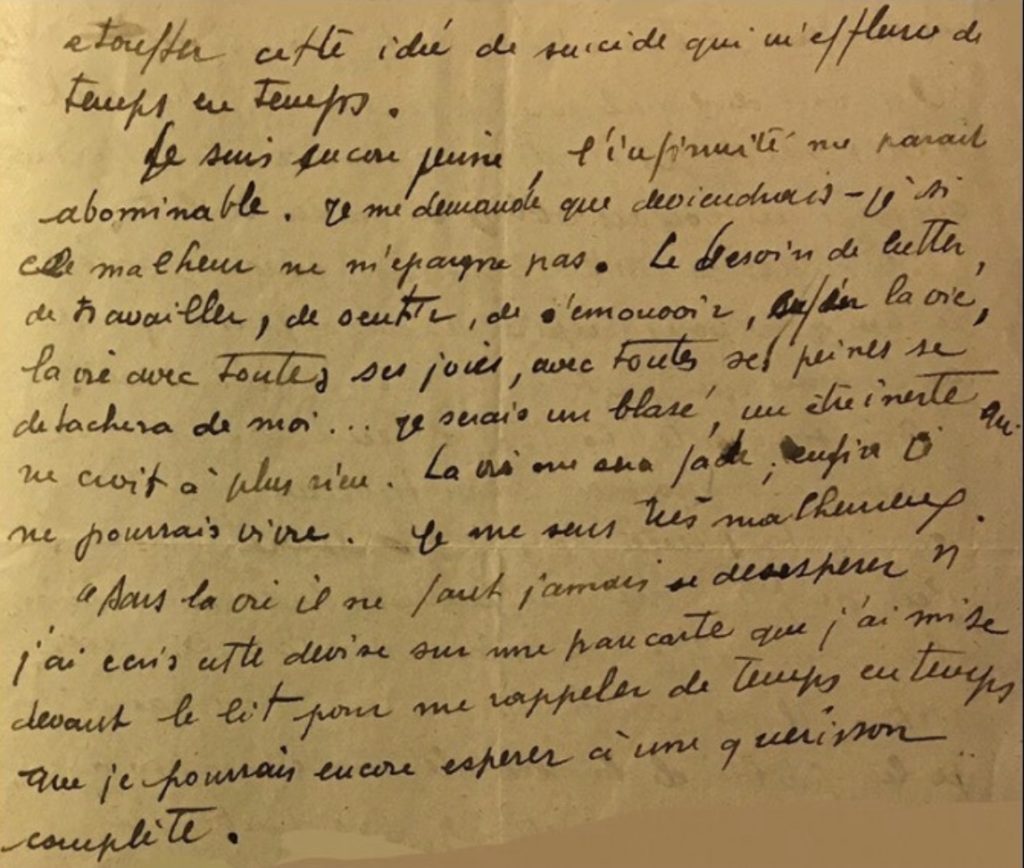
The painter died young (in 1941, at the age of 27), admittedly of a domestic accident in Laos, if we are to believe the testimonies, always subject to caution, especially from/to Vietnam in the 1940s…
But as we have seen, death, the prowler, and life, the impossible, are at the heart of Trần Bình Lộc’s work. Our painting bears witness to this with ease.
But we must also mention Trần Bình Lộc’s insertion into the Chinese sphere.
Another of his works, executed in 1934 and reproduced below, informs the reader of this.
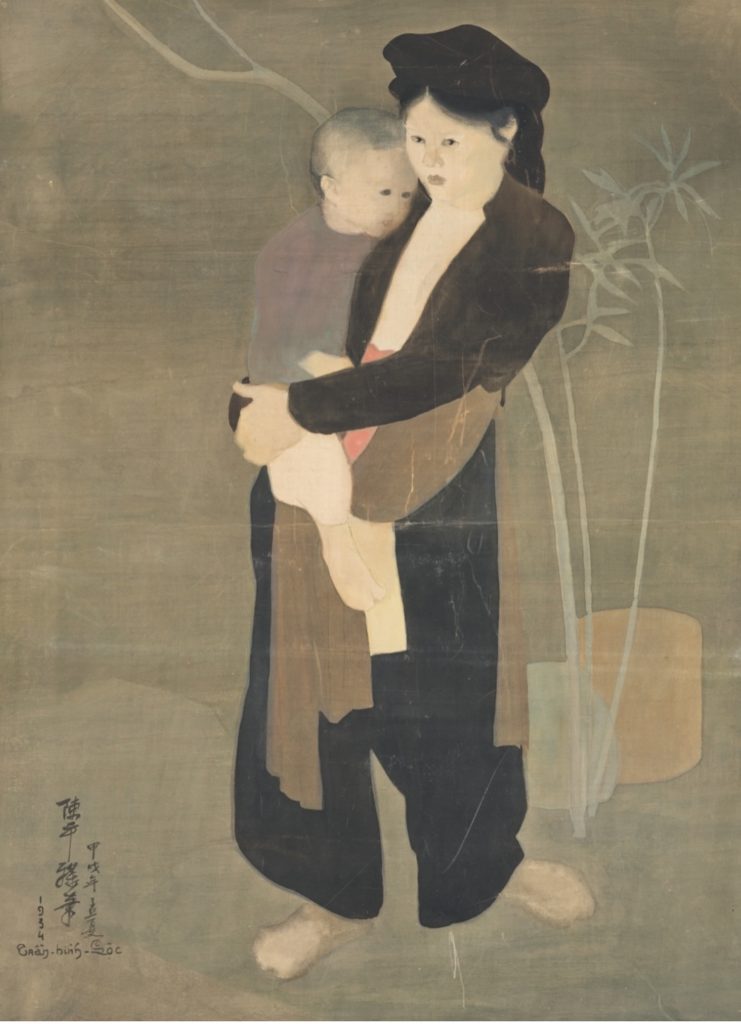
These are probably the same models. The overall look is more allusive. No more austere but opulent interior, but an almost devastating exterior austerity. The scrawny shrubbery plants are pl anted far from containers deemed useless. The child is held, not coaxed. A cameo of browns, a vertical use of ink. None of the dynamics of the 1935-36 work. In 1934, the representation is static.
Both works seem to testify to what we today call the “bipolarity” of a being. In both cases, ephemeral happiness or existential weariness, Trần Bình Lộc freezes the scene because he knows perfectly well that it is even more fleeting than fleeting.
The 1934 work also provides us with several additional elements for understanding the artist and his cultural rather than artistic affiliation with the Chinese tradition.
This is evidenced by its double-reading dating and inscription system (ideograms and Roman letters).
The work is signed from top to bottom left, in Chinese, in Romanized (“overplayed”) letters below and dated, 1934, in numerals and inscribed in Chinese (in addition to the signature) from top to bottom:
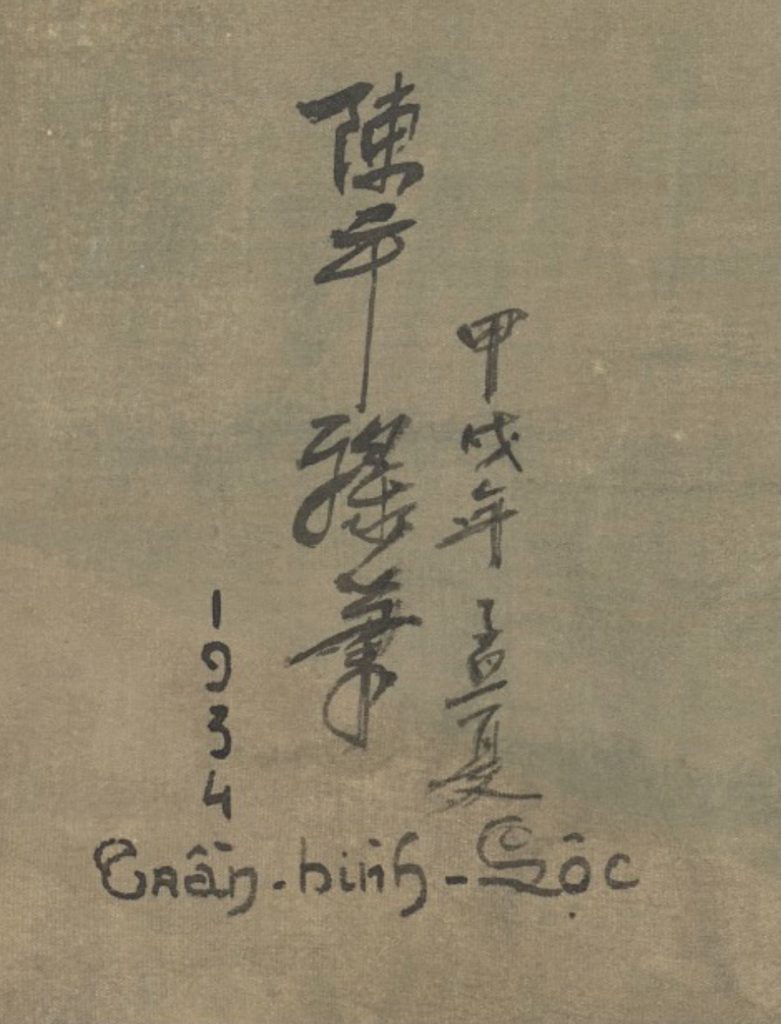
Jia Wu Nian Meng Xia :


- 甲 and 戊 refer to the Chinese sexagesimal cycle
- 年 means “year”
- 孟夏 means beginning of summer (April).
Which we must accept as the beginning of the summer of 1934 (incidentally, a period when the artist’s pains increased with the heat, which is one of the explanations for the meaning of the work).
Like Tran Van Can and Nguyen Khang, among others, at the same time, Trần Bình Lộc keeps his distance from the romanization of Vietnamese writing, although not as much as they do. He doesn’t disavow it, he doesn’t deny it, but he feels it’s necessary to accompany it wi th the Chinese script. The unsurpassable question of cultural legitimacy, and even more of its claim…
Too gifted, too sensitive, he died too soon, and Trần Bình Lộc has left us with an incomplete body of work. We would have loved to analyze his evolution over time. Did he plateau like Nguyen Phan Chanh, Luong Xuan Nhi or Mai Thu? Produced little like Luu Van Sin? Performed almost nothing like Do Duc Thuan? Or did he innovate, stimulated by the west wind like Le Pho or Vu Cao Dam?
We’ll never know.
Art as a tragic figure.
Jean-François Hubert
PS: Let’s just remember that we may more rarely come across another Trần Bình Lộc signature that we give here and that doesn’t concern our substantive point:
